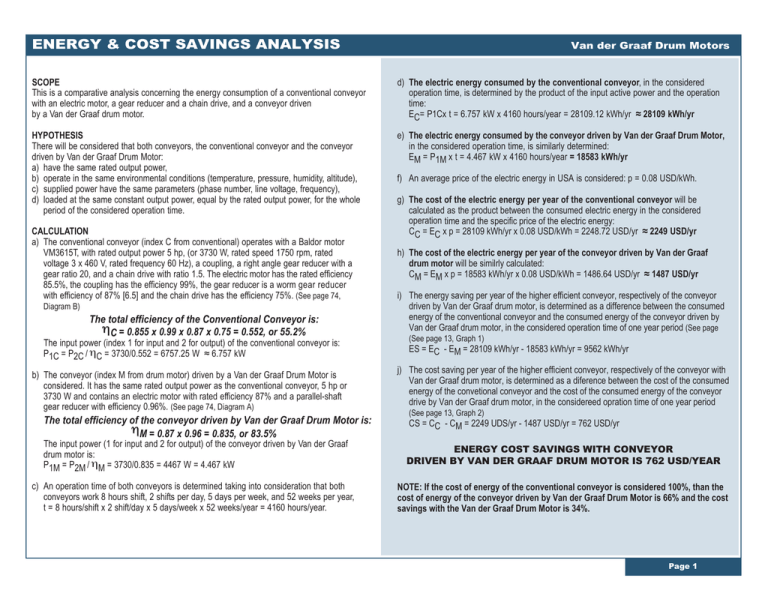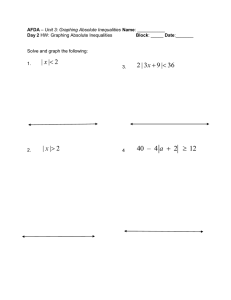Drum Motor Savings Analysis_pg1
advertisement

ENERGY & COST SAVINGS ANALYSIS Van der Graaf Drum Motors SCOPE This is a comparative analysis concerning the energy consumption of a conventional conveyor with an electric motor, a gear reducer and a chain drive, and a conveyor driven by a Van der Graaf drum motor. d) The electric energy consumed by the conventional conveyor, in the considered operation time, is determined by the product of the input active power and the operation time: EC= P1Cx t = 6.757 kW x 4160 hours/year = 28109.12 kWh/yr ≈ 28109 kWh/yr HYPOTHESIS There will be considered that both conveyors, the conventional conveyor and the conveyor driven by Van der Graaf Drum Motor: a) have the same rated output power, b) operate in the same environmental conditions (temperature, pressure, humidity, altitude), c) supplied power have the same parameters (phase number, line voltage, frequency), d) loaded at the same constant output power, equal by the rated output power, for the whole period of the considered operation time. e) The electric energy consumed by the conveyor driven by Van der Graaf Drum Motor, in the considered operation time, is similarly determined: EM = P1M x t = 4.467 kW x 4160 hours/year = 18583 kWh/yr CALCULATION a) The conventional conveyor (index C from conventional) operates with a Baldor motor VM3615T, with rated output power 5 hp, (or 3730 W, rated speed 1750 rpm, rated voltage 3 x 460 V, rated frequency 60 Hz), a coupling, a right angle gear reducer with a gear ratio 20, and a chain drive with ratio 1.5. The electric motor has the rated efficiency 85.5%, the coupling has the efficiency 99%, the gear reducer is a worm gear reducer with efficiency of 87% [6.5] and the chain drive has the efficiency 75%. (See page 74, Diagram B) The total efficiency of the Conventional Conveyor is: ηC = 0.855 x 0.99 x 0.87 x 0.75 = 0.552, or 55.2% The input power (index 1 for input and 2 for output) of the conventional conveyor is: P1C = P2C / ηC = 3730/0.552 = 6757.25 W ≈ 6.757 kW b) The conveyor (index M from drum motor) driven by a Van der Graaf Drum Motor is considered. It has the same rated output power as the conventional conveyor, 5 hp or 3730 W and contains an electric motor with rated efficiency 87% and a parallel-shaft gear reducer with efficiency 0.96%. (See page 74, Diagram A) The total efficiency of the conveyor driven by Van der Graaf Drum Motor is: ηM = 0.87 x 0.96 = 0.835, or 83.5% f) An average price of the electric energy in USA is considered: p = 0.08 USD/kWh. g) The cost of the electric energy per year of the conventional conveyor will be calculated as the product between the consumed electric energy in the considered operation time and the specific price of the electric energy: CC = EC x p = 28109 kWh/yr x 0.08 USD/kWh = 2248.72 USD/yr ≈ 2249 USD/yr h) The cost of the electric energy per year of the conveyor driven by Van der Graaf drum motor will be similrly calculated: CM = EM x p = 18583 kWh/yr x 0.08 USD/kWh = 1486.64 USD/yr ≈ 1487 USD/yr i) The energy saving per year of the higher efficient conveyor, respectively of the conveyor driven by Van der Graaf drum motor, is determined as a difference between the consumed energy of the conventional conveyor and the consumed energy of the conveyor driven by Van der Graaf drum motor, in the considered operation time of one year period (See page (See page 13, Graph 1) ES = EC - EM = 28109 kWh/yr - 18583 kWh/yr = 9562 kWh/yr j) The cost saving per year of the higher efficient conveyor, respectively of the conveyor with Van der Graaf drum motor, is determined as a diference between the cost of the consumed energy of the convetional conveyor and the cost of the consumed energy of the conveyor drive by Van der Graaf drum motor, in the considereed opration time of one year period (See page 13, Graph 2) CS = CC - CM = 2249 UDS/yr - 1487 USD/yr = 762 USD/yr The input power (1 for input and 2 for output) of the conveyor driven by Van der Graaf drum motor is: P1M = P2M / ηM = 3730/0.835 = 4467 W = 4.467 kW ENERGY COST SAVINGS WITH CONVEYOR DRIVEN BY VAN DER GRAAF DRUM MOTOR IS 762 USD/YEAR c) An operation time of both conveyors is determined taking into consideration that both conveyors work 8 hours shift, 2 shifts per day, 5 days per week, and 52 weeks per year, t = 8 hours/shift x 2 shift/day x 5 days/week x 52 weeks/year = 4160 hours/year. NOTE: If the cost of energy of the conventional conveyor is considered 100%, than the cost of energy of the conveyor driven by Van der Graaf Drum Motor is 66% and the cost savings with the Van der Graaf Drum Motor is 34%. Page 1 ENERGY & COST SAVINGS ANALYSIS 25,000 20,000 18583 15,000 5,000 0 Time (years) TAIL PULLEY CONVENTIONAL PULLEY Graph 2: Energy Cost Comparison (@ 0.08 USD/kWh) Chain Drive η = 75% 3,000 GEAR BOX CONVEYOR BELT 5 HP MOTOR TAIL PULLEY Coupling η = 99% Electric Motor η = 88.5% TOTAL EFFICIENCY 55.2% Energy Costs (US$/year) 2,500 Gear Reducer η = 87% 2,000 2249 (100%) 1487 1,500 1,000 500 0 5HP CONVENTIONAL CONVEYOR DRIVE Diagram B: Conveyor Driven by a Conventional Conveyor Drive 9526 ENERGY SAVINGS 10,000 (66%) 762 (34%) COST SAVINGS TOTAL EFFICIENCY 83.5% CONVEYOR BELT 28109 5HP DRUM MOTOR CONVEYOR DRIVE Electric Motor η = 87% 30,000 5HP DRUM MOTOR CONVEYOR DRIVE Gear Reducer η = 96% Energy Consumption (kWh/year) 5 HP DRUM MOTOR Graph 1: Energy Consumption Comparison 5HP CONVENTIONAL CONVEYOR DRIVE Diagram A: Conveyor Driven by a Van der Graaf Drum Motor Van der Graaf Drum Motors Time (years) Page 2




